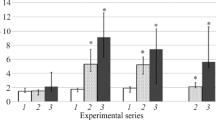Summary
The levels of plasma testosterone, testosterone-oestradiol binding globulin (TeBG) and total serum acid phosphatase (TSAP) following antiandrogenic hormone therapy were investigated in 17 patients with prostatic carcinoma. The low levels of plasma total and free testosterone induced by castration decreased further after diethylsitlboestrol diphosphate (DES-D) administration. Plasma TeBG binding capacity after castration was 118.9% of the pre-treatment level and increased to 193.9%, 204.0% and 212.7% at 1, 2 and 3 weeks after DES-D dosing. The in vitro binding of 3H-testosterone to TeBG was not influenced in the presence of DES-D or stilboestrol. Clinical response following the DES-D therapy was associated with a decrease in the levels of TSAP. A significantly inversed correlation was found between the decrease in TSAP and increase in TeBG at completion of DES-D therapy. These results suggest that the high binding capacity of TeBG lowers the biologically active fraction of testosterone and thus may produce clinical effects.
Similar content being viewed by others
References
Bartsch W, Hosrt HJ, Becker H, Nehse, G (1977) Sex hormone binding globulin binding capacity, testosterone, 5α-dihydrotestosterone, oestradiol and prolactine in plasma of patients with prostatic carcinoma under various types of hormonal treatment. Acta Endocrinol 85:650
Houghton, AL, Turner, R, Cooper EH (1977) Sex hormone binding globulin incarcinoma of the prostate. Br J Urol 49:277
Iatron (1970) Technical Bulletin ACP-S. Sankyo-Junyaku Co. Ltd., Tokyo
Ishibe T, Usui T, Nihira H (1974) Prognostic usefulness of serum acid phosphatase levels in carcinoma of the prostate. J Urol 112: 237
Leinonen, P, Hammond, GL, Lukkarinen, O, Vihko, R (1979) Serum sex hormone binding globulin and testosterone binding after estradiol administration, castration and their combination in men with prostatic carcinoma. Invest Urol 17:24
Nieschlag E, Loriaux DL (1972) Radioimmunoassay for plasma testosterone. Klin Chem Klin Biochem 10:164
Pearlman WH (1970) Measurement of testosterone binding sites. In: Diczfalusy E (ed) Karolinska symposia on research methods in reproductive endocrinology, 2nd symposium, Steroid assay by protein binding, Stockholm
Ritzen EM, French FS, Weddington SC, Nayfeh SN, Hansson V (1974) Steroid binding in polyacrylamide. gels. Quantitation at steady state conditions. J Biol Chem 249:6597
Schnorr D, Mebel M, Dörner G, Stahl, F, Rohde W (1976) Endocrine effects of oestrogen treatment in patients with prostatic carcinoma. Eur Urol 2:85
Author information
Authors and Affiliations
Rights and permissions
About this article
Cite this article
Usui, T., Sagami, K., Kitano, T. et al. The changes in the binding capacity of testosterone-oestradiol binding globulin (TeBG) following castration and DES-D administration in patients with prostatic carcinoma. Urol. Res. 10, 119–122 (1982). https://doi.org/10.1007/BF00255953
Accepted:
Issue Date:
DOI: https://doi.org/10.1007/BF00255953




